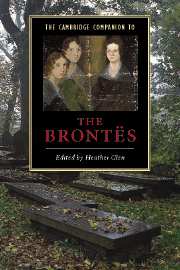Book contents
- Frontmatter
- Introduction
- 1 The Haworth context
- 2 'Our plays': The Brontë Juvenilia
- 3 The poetry
- 4 'Three distinct and unconnected tales': The Professor, Agnes Grey and Wuthering Heights
- 5 'Strong family likeness': Jane Eyre and The Tenant of Wildfell Hall
- 6 Shirley and Villette
- 7 'Getting on': ideology, personality and the Brontë characters
- 8 Women writers, women's issues
- 9 The Brontës And Religion
- 10 The Brontë myth
- Further reading
- Index
- Series List
Introduction
Published online by Cambridge University Press: 28 May 2006
- Frontmatter
- Introduction
- 1 The Haworth context
- 2 'Our plays': The Brontë Juvenilia
- 3 The poetry
- 4 'Three distinct and unconnected tales': The Professor, Agnes Grey and Wuthering Heights
- 5 'Strong family likeness': Jane Eyre and The Tenant of Wildfell Hall
- 6 Shirley and Villette
- 7 'Getting on': ideology, personality and the Brontë characters
- 8 Women writers, women's issues
- 9 The Brontës And Religion
- 10 The Brontë myth
- Further reading
- Index
- Series List
Summary
The Brontë sisters are not obviously difficult writers. Indeed, they may seem all too easily accessible. Generations of readers have thrilled to the passion of Cathy and Heathcliff, identified with the sufferings of Lucy Snowe and Agnes Grey, succumbed to Mr Rochester's dark allure. These are not texts which seem to require elucidation, but stories which millions have urgently, if often incoherently, felt to be speaking of and to their own most intimate concerns. And if - as Charlotte Brontë acknowledged, in the Biographical Notice with which, in 1850, she prefaced her sisters' novels - their strangeness has needed explanation, explanation has seemed readily to hand. Since the publication of that Notice, and of Elizabeth Gaskell's Life of Charlotte Brontë seven years later, the key to the Brontë s' works has been found - straightforwardly or more indirectly, both by ordinary reader and professional academic - in the peculiar circumstances of their authors' brief and tragic lives. The story of those lives has, indeed, assumed an almost mythic place in the English cultural imagination: after Shakespeare's Stratford, Haworth Parsonage is England's most visited literary shrine.
- Type
- Chapter
- Information
- The Cambridge Companion to the Brontës , pp. 1 - 12Publisher: Cambridge University PressPrint publication year: 2002
- 1
- Cited by



